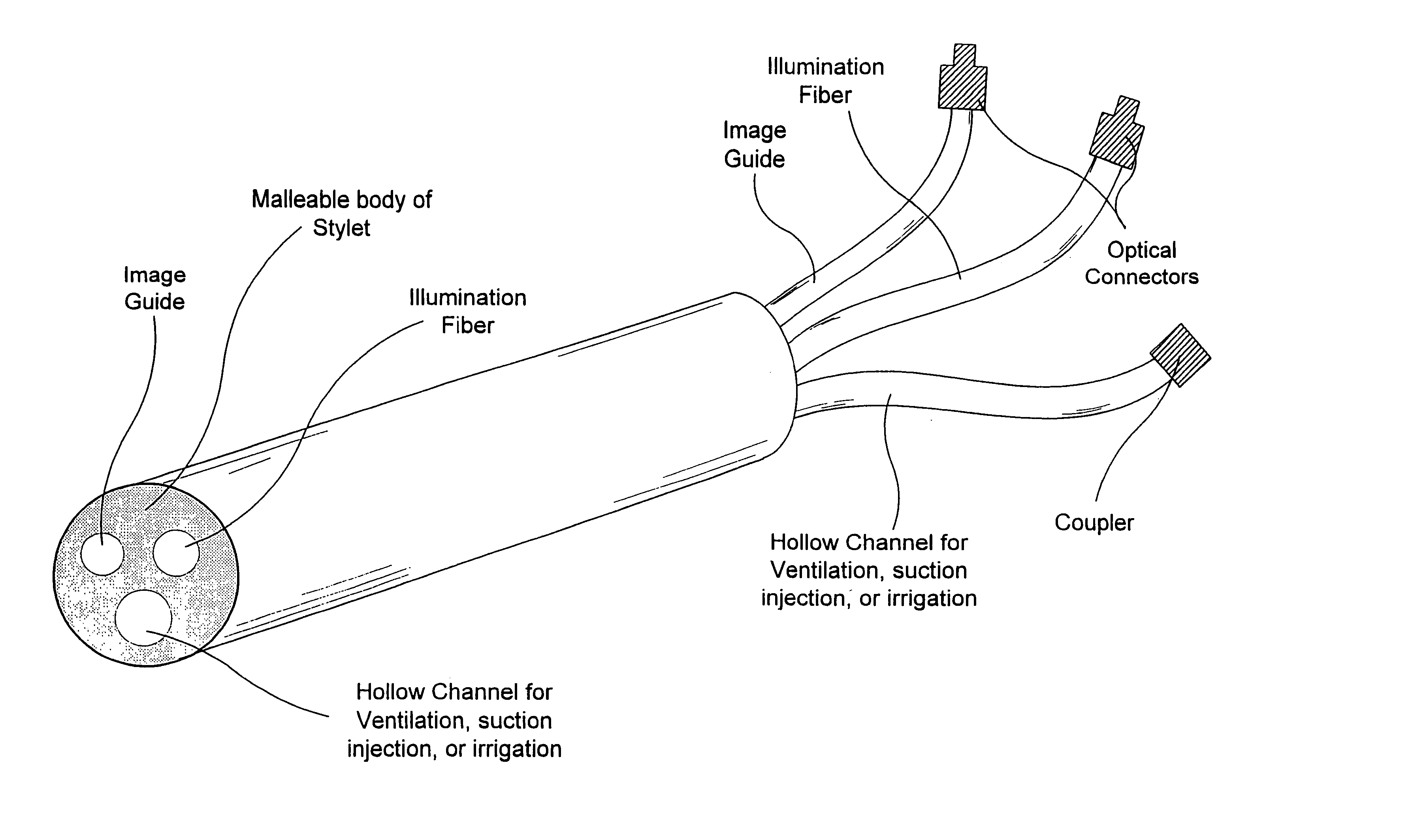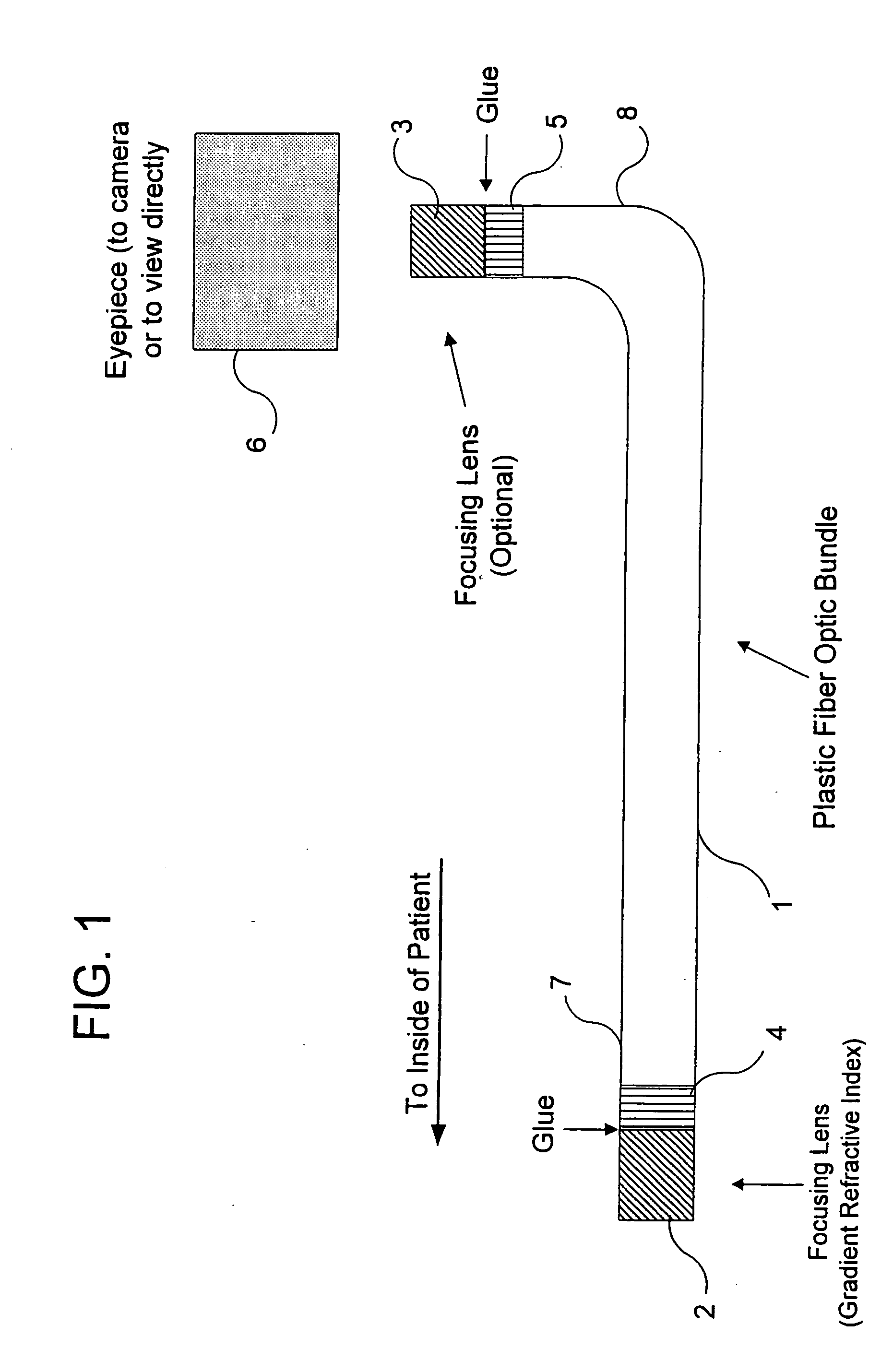Imaging scope
a fiber optic and scope technology, applied in the field of fiber optic imaging scopes, can solve the problem of only being able to achieve the degree of precision, and achieve the effects of reducing costs, avoiding breakage, and high-precision optical, mechanical, ergonomical and physical characteristics
- Summary
- Abstract
- Description
- Claims
- Application Information
AI Technical Summary
Benefits of technology
Problems solved by technology
Method used
Image
Examples
example 1
[0071] The device of the subject invention not only makes intubation easier and more accurate, but also reduces the potential for inflicting injury with the laryngoscope blade. Using the device of the subject invention, the practitioner only needs to use the laryngoscope blade to control the position of the patient's tongue. The device can also be used without a laryngoscope and for nasotracheal intubation.
[0072] The device of the subject invention can comprise a bundle of 10,000 individual plastic optical fibers (bundle is approximately 1.0 millimeter in diameter). The resolution of the image is comparable to an existing glass fiberoptic bronchoscope, providing good visualization of the patient's airway.
[0073] The manufacturing process places the bundle integral to a standard malleable stylet. An additional fiber may be used for illuminating purposes. Suctioning and insufflation can be added by adding an additional channel if desired.
[0074] A focusing lens (i.e., gradient refrac...
example 2
[0075] Referring to FIGS. 2A, 2B, 2C, 2D, 2E, and 2F, this example provides three illustrative combinations of image guide, illuminating fiber, stylet, and / or sheath. FIGS. 2A and 2D illustrate a longitudinal cross section and a transverse cross section, respectively, of the distal end of a sheath designed to fit over a plastic optical fiber image guide. The sheath covers the distal tip of the image guide with a transparent end plate. In this case, any illuminating fibers and / or stylets would not be enclosed within this sheath, although they could have their own sheaths.
[0076]FIG. 2B and 2E illustrate a longitudinal cross section and a transverse cross section, respectively, of the distal end of a sheath designed to fit over a plastic optical fiber image guide, wherein the sheath comprises an illumination fiber. The distal end of the illumination fiber is not covered by the sheath, in this example, so as to not impair the image. Accordingly, the illuminating fiber can be disposed o...
example 3
[0078] It is sometimes necessary to replace an endotracheal tube in a patient, for example when the tube no longer provides an adequate airway. In a specific embodiment, the subject invention can permit the easy removal of one endotracheal tube and its replacement with a new one.
[0079] A device in accordance with the subject invention can be inserted into the patient's trachea, generally through an existing tracheal tube, until the distal tip is at or near the tip of the tube. Oxygen for ventilation, suction or irrigation can also be applied in succession via, for example, quick fit connectors to the proximal end if desired. Once the anatomy is visualized, the light source, camera or eyepiece, and oxygen / suction / irrigation can all be disconnected from the proximal end of the subject device. The endotracheal tube can then be completely removed by sliding it out of the trachea, along, and off the proximal end of the subject device. The connectors of the subject device can be of a sui...
PUM
 Login to View More
Login to View More Abstract
Description
Claims
Application Information
 Login to View More
Login to View More - R&D
- Intellectual Property
- Life Sciences
- Materials
- Tech Scout
- Unparalleled Data Quality
- Higher Quality Content
- 60% Fewer Hallucinations
Browse by: Latest US Patents, China's latest patents, Technical Efficacy Thesaurus, Application Domain, Technology Topic, Popular Technical Reports.
© 2025 PatSnap. All rights reserved.Legal|Privacy policy|Modern Slavery Act Transparency Statement|Sitemap|About US| Contact US: help@patsnap.com



